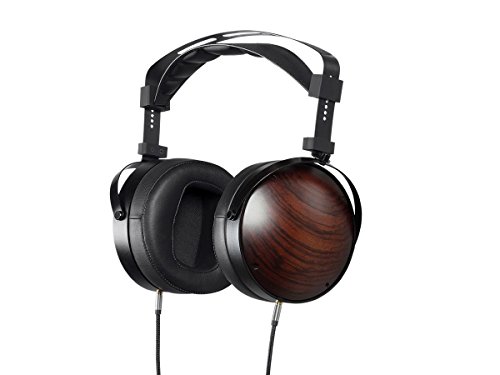How Do Planar Magnetic Headphones Work?
Planar magnetic headphones are less distortion-free than dynamic drivers. This is because it vibrates the entire diaphragm, not just the portion that connects to the voice coil.
They also have a wider soundstage, with better separation and differentiate capabilities. However, they do leak a little more, and require isolation to keep from disturbing those near you.
The diaphragm
The diaphragm plays a crucial role in [almost] all sound transducers (headphones and loudspeakers and microphones) that move air to produce sound. In headphones it's a flat part of diaphragm that is suspended between two magnets that create an electromagnetic field when activated by audio signals. In a planar magnetic headphone the electric current generated by a headphone's source is transmitted to the diaphragm via a coil. The coil creates a magnetic field that causes the diaphragm's to vibrate.
The sound produced is transmitted to your ear via the diaphragm's suspension, which is typically made from an artificial material, such as titanium or neodymium. The diaphragm can then resonate with your ear using various frequencies. Planar magnetic headphones can provide high SPLs, but without sounding distorted.
In addition to being able to reproduce high SPLs, planar magnetic headphones also provide a more immersive soundstage. The reason for this is because the flat diaphragm creates the sound wavefront in a planar manner, rather than the narrow spherical wavefronts that are found in the majority of dynamic drivers. The headphones produce a more natural soundstage and are easier to localize.
Transient response is another benefit of planar magnet headphones. This is due to the ability of headphones with planar magnetics to reproduce peaks that last only a few seconds, like cymbal smacks and kick drum hits. planar headphone has a large diameter and stretches evenly across the surface, which means there's no distortion when the peaks are achieved.
Planar magnetic headphones have a few disadvantages you should take into account when choosing a pair. For one, they tend to be more expensive than their dynamic counterparts. This is mainly due to the design of their drivers that can be complicated, as well as the heritage of the brand behind them.
There are many budget-friendly planar magnets that cost less than $100. They are available in closed-back and open-back styles. You can pick the one that best suits your preferences in music. The HIFIMAN Arya Stealth Magnets Edition and Audeze LCD-2 Classics are some of the top options on the market.

The voice coil
Planar magnetic headphones are known for their precision and accuracy, offering exceptional detail and clarity across the entire frequency range. This is due in large part to the flat, thin diaphragm sandwiched between magnet arrays. When an electrical signal from your source of audio is transmitted to the vocal coil, the conductive materials windings of the vocal coil react with the magnet field and cause the dialyms to vibrate. This results in sound waves.
The advantage of the planar-type driver is that every vibration is equally distributed and occurs at the same rate regardless of the location where the diaphragm is placed within the magnetic field. This results in a more stable sound quality, with less distortion and a more uniform wavefront that's easier on the ears. Contrary to this dynamic drivers tend to produce an elongated sound wavefront that's less consistent and can be distracting.
Planar magnetic drivers because of their working method, require a stronger amplification system. They are also heavier and bulkier due to the larger, more flexible membrane. They require an external amplifier or DAC to drive them.
Planar magnetic drivers can be more expensive since they are usually made of high-quality materials. However, a handful of specialized HiFi audio headphone companies have begun to revive this older technology in recent years. We're seeing a wide range of new headphones with planar magnet drivers that provide an excellent listening experience.
Like everything else in life, the decision between dynamic and planar magnetic headphones is based on your personal preferences and budget. The headphones with a magnetic design have an enlargement of the soundstage than dynamic models and are renowned for their incredible quality and precision. However, they are typically more expensive and many listeners prefer the punchy bass and warm sound signature of dynamic headphones.
In general dynamic driver headphones offer a little more punch and slam than those with planar magnetic designs however, the differences aren't always apparent to the majority of listeners. They are also better at clarity and imaging. There are exceptions to the rule. Some excellent planar-magnetic headsets can be bought at affordable costs.
Magnets
In a typical headphone that has a dynamic driver the electrical impulses generated by your source of audio travel through a coil of conductive material that interacts with the magnetic fields in the driver. These are used to bend the diaphragm's flatness and generate sound waves. Planar magnetic headphones however make use of a thin layer of conductive material, which is sandwiched between two powerful magnets. They are more difficult to manufacture, which is why they're more expensive.
They also tend to be bigger and heavier because of their design which means they require more space around the drivers. They also use more power than their more dynamic counterparts, which means they'll require a dedicated headphone amplifier to maximize their performance. While this isn't always a issue, it's something you should be aware of when looking at these headphones.
While it's not true for all headphones, many of the top headphones with a planar design will provide an airier and more spacious sound than their more dynamic counterparts. This gives them the impression of space, which can be quite appealing for some listeners. The soundstage they provide is also a bit bigger and can be useful when listening to music in a group.
The open-back design is a favorite choice for many designer headphone brands, including the likes of HiFiMAN and Audeze. They're not as well-known as closed-back ones however they're a great way to experience planar magnetic technology. For instance the HiFiMAN Sundara offers a great introduction to the speed, accuracy, and detail of these headphones for a low price.
The housing
You might have heard of planar magnet headphones if you are an audiophile or even if you like good music. They have a distinctive look, with flat diaphragms that are embedded into the headphone. They are available in open-back and over-ear designs. Apart from the distinctive design, these headphones use different working principles that are different from dynamic drivers.
Contrary to the traditional driver, which uses the voice coil to create sound waves Planar magnetic headphones employ magnets that move the diaphragm back and forth to generate sound. Depending on the design, these arrays can be situated on either or both sides of the diaphragm. The magnets are activated by an electrical signal that passes through the voice coil and causes it to vibrate. The vibrations create magnetic fields which interact with the magnets at the opposite side of the diaphragm. The magnetic fields cause the diaphragms to push and pull. The audio signal is represented by sound waves.
Because of this, the sound of headphones with planar magnetic design is typically more resonant and have greater bass extension capabilities. The large, flat diaphragm responds more quickly to changes in input signals, which means they are able to respond faster to bass response and are less prone to distortion. This gives them a more controlled, tight audio quality that some audiophiles find appealing.
These headphones can reproduce higher frequencies, but they lack the slam and punch that modern dynamic driver headphones offer. They can be difficult to hear for those who want to listen to metal or hard rock music.
Because of their unique design they are more expensive than other headphone models. They also require a specific amplifier and digital audio converter to supply the drivers with power. This can add up to an expensive cost increase for some buyers, however many people believe the sound quality is worth it. Regardless, it's important to keep in mind that there are other headphones available to those who don't want spend more than they need to.
